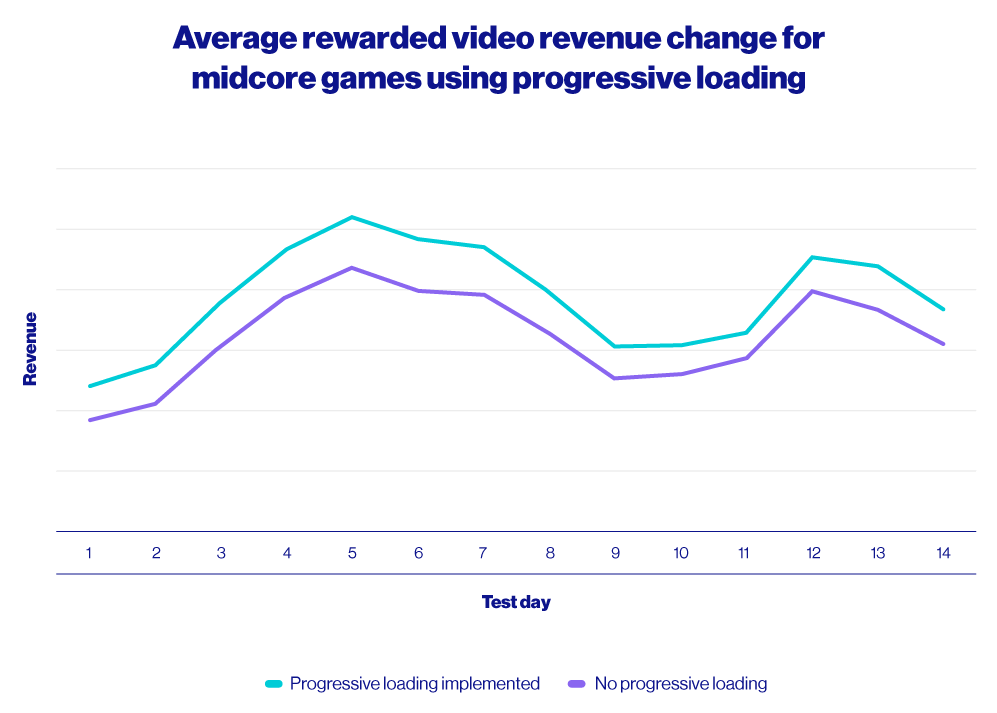Rewarded videos are the king of ads - which when implemented smartly can be essential parts of a mobile game’s core loop. However, succeeding with rewarded video requires a well-thought-out plan and partnering with the right mediation platform - one that has the strongest tech tools to support a high-growth rewarded video strategy.
Progressive loading is a mechanism exclusive to ironSource that helps ensure a rewarded video is always available to play with zero latency, even just after another rewarded video closes. Read on for tips on how to better manage your app’s ad latency.
Manually managing latency
Developers have dedicated considerable time to optimizing latency for their rewarded video strategy - which refers to the time between loading an ad and having an ad ready to show. Sometimes, a delay can occur when the publisher’s request to fill the ad space with an advertiser’s ad isn’t met, typically due to a lack of demand from the ad networks in that particular moment. In this case, the end result is a poor user experience: the user tapped on the traffic driver, expecting to watch a video ad and earn a reward, but is left staring at a blank screen for a certain amount of time.
Developers historically chose from three approaches to manage latency’s impact on the user experience:
- The first approach is to only show users a rewarded video traffic driver when there’s an ad ready to display.
- The second option is to always display the traffic driver, and if the ad inventory isn’t filled, users are simply left staring at a blank screen until they exit out.
- The third option is the same as the second, just with a slightly better user experience - if an ad isn’t available, a pop up will appear that states this.
The drawbacks of these options are clear, harming ARPDAU, the user experience, or both. To make up for it, developers today generally focus on optimizing their waterfalls to reduce latency by slimming down the size of waterfalls - a single publisher could have dozens of instances for multiple geos and apps, which delays the ad serving process.
Still, running a highly optimized ship with only the best performing instances - while minimizing the impact on CPM from removing demand sources - requires manual upkeep. Even when executed well, zero latency is not attainable through traditional waterfall optimization.
Removing latency with progressive loading technology
With progressive loading technology - which currently is only available on ironSource’s mediation platform - publishers don’t need to worry about a poor user experience or the burden of latency management. Instead, they can focus on perfecting their rewarded video placement strategy, and maximize ARPDAU and retention as a result. The positive experience rewarded video creates for users strengthens game retention and lays the foundation for strong engagement rate and usage rates - and in turn ARPDAU.
Not only does this ensure a perfect user experience by enabling users to watch multiple rewarded videos without a delay in between, it also means developers don’t need to deal with the time-consuming burden of latency management.
Since progressive loading was implemented in ironSource’s mediation, we've seen revenue shoot up between 3% to 20% per app. This range is mainly affected by genre - the deeper the game, such as those in the casual or midcore categories, the more significant the impact of progressive loading. That's because these games by design provide more opportunities for users to watch rewarded videos. In addition, games in these categories have more complex in-game economies, which the ads' rewards provide real value to.

Design tips to leverage progressive loading
With progressive loading technology automatically managing your latency, it becomes much easier to show several rewarded videos in a row. Encourage users to watch as many videos as possible with the following tips:
Use stacked multiplier rewards
To maximize usage rates of your rewarded video ads and leverage the power of progressive loading, we recommend using stacked multiplier rewards for a strip of rewarded videos. For example, the user watches one video and unlocks a "double income for 4 hours" reward. If they watch another video in the strip, 4 more hours will be added to the boost. Typically, developers add a limit to this cycle, for example up to 12 hours worth of boosts.
Offer a special reward
Another option is encouraging users to watch several rewarded videos in a row to get a mystery box or a specific reward. We’ve also seen developers offer users the ability to open a treasure chest by watching a rewarded video, and as soon as they open it, offer them the possibility of doubling their chest loot by watching another rewarded video.
That’s not all - a user may decide to open up a standard rewarded video placement on the game’s home screen multiple times in a row - especially in idle games that revolve around currency accumulation or scaling production. Each rewarded video ad could offer a multiplier that doubles or triples the earnings from the previous ad. Whatever the scenario and session depth, users can experience multiple ads with zero latency between them thanks to progressive loading.
A/B test various rewards
Make sure you A/B test different types of rewards and see which ones have the biggest impact on engagement and usage rates for your rewarded video ad placements. Maximizing the value you provide your players and encouraging them to watch multiple ads should be your focus - progressive loading technology will take care of the zero latency part for these multiple ads to ensure a perfect user experience.
These best practices will keep users happy and engaged in your game, keep them coming back to your rewarded video placements, and as a result, driving up your ARPDAU over the long-run. Sign up to the ironSource platform to supercharge your rewarded video strategy with progressive loading now.



